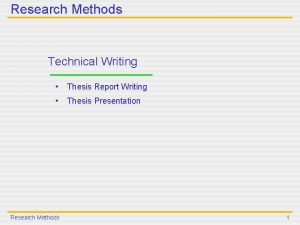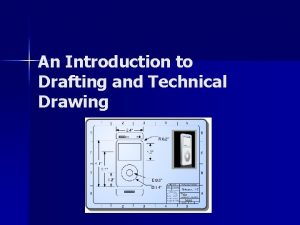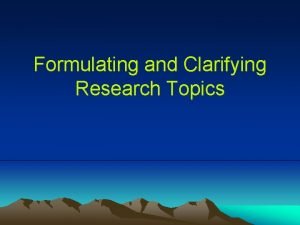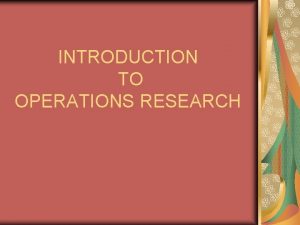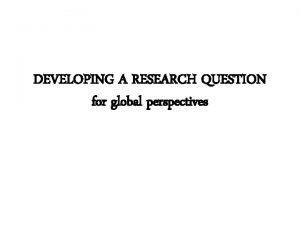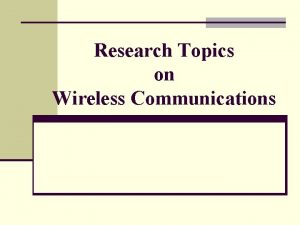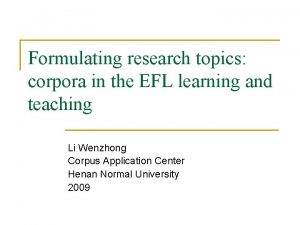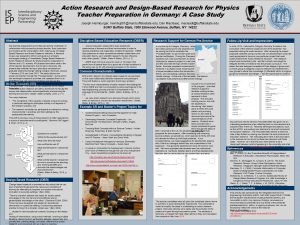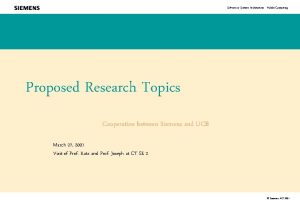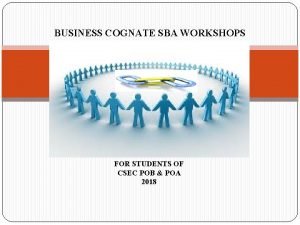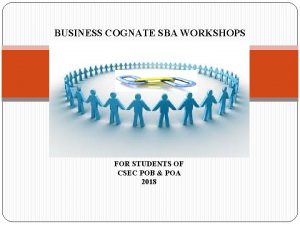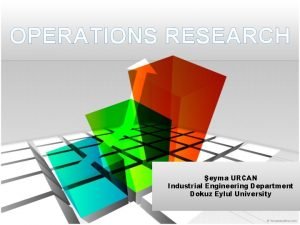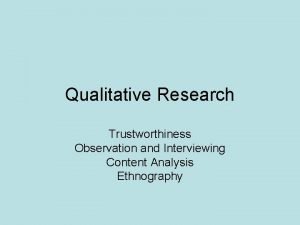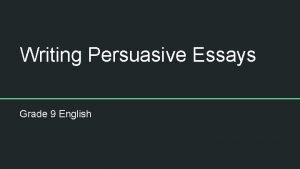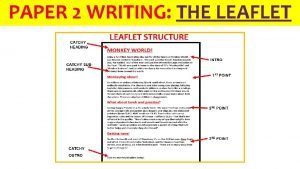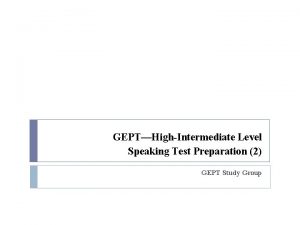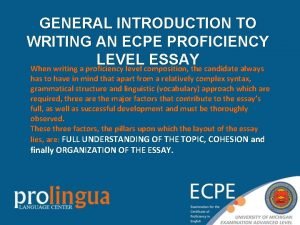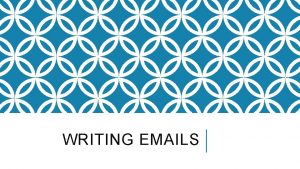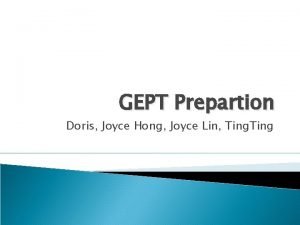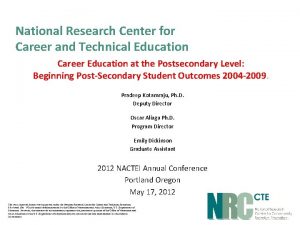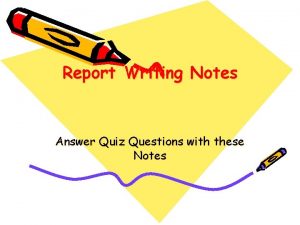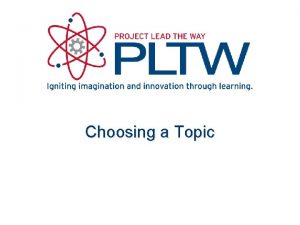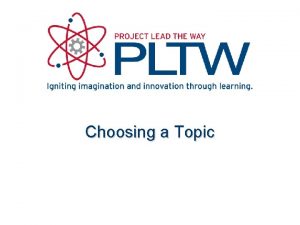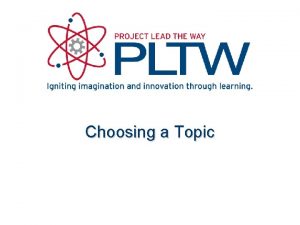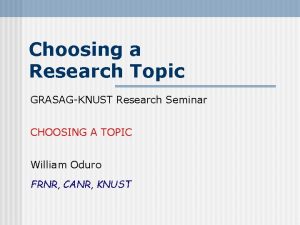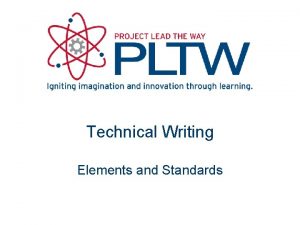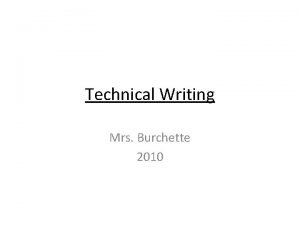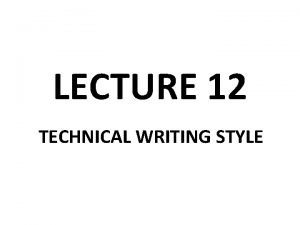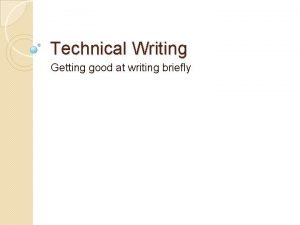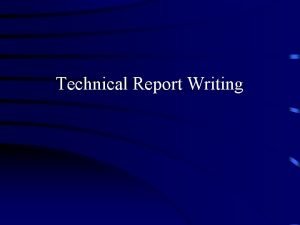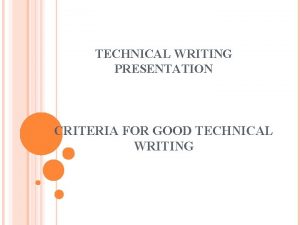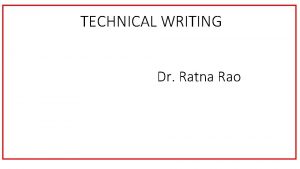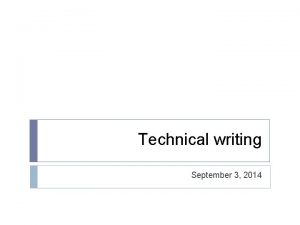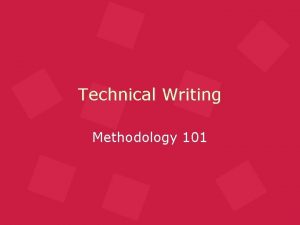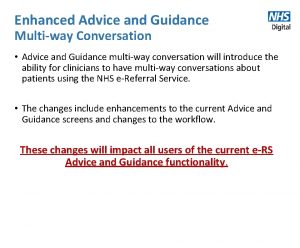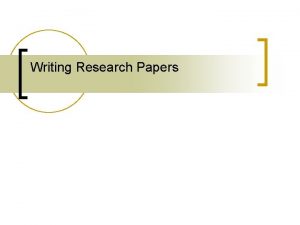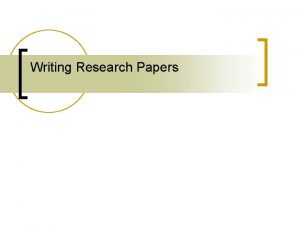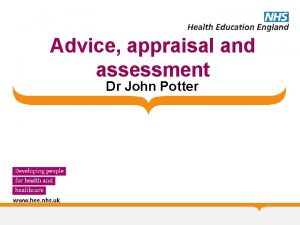Advice on Choosing Research Topics and Writing Technical




































- Slides: 36

Advice on Choosing Research Topics and Writing Technical Papers (Advice for students and new faculty) Bruce E. Logan Penn State University Engineering Energy & Environmental Institute

Topic! 2

The better the topic of your research, the easier it is to publish • When planning an avenue of research, realize that some topics are “hotter” (more important? ) than others. • “Hot” topics sell better (hopefully because they are needed) – Nano/bio/info topics – New materials, energy sources, etc. • If you work on traditional areas, such as wastewater treatment, it will be very difficult to get good citation numbers – (There are just not that many people in the field, and it is not well funded). 3

Important vs Incremental? Both! • Mapping expeditions – When you map/survey an area, you always come back with data. – Such studies are useful!. . . But they rarely are big discoveries or have a big impact. – MS projects good for new researchers, and a Ph. D student might have some of this especially when starting out. • Hunting expeditions – Sometimes you should go after the bear and ignore the squirrels – When you land the “big game”, you get a big reward – New discoveries are more important than building on existing information, but it is much riskier (you may go hungry) – Ph. D students must have some (not all!) of these types of hunting investigations 4

The Logan Group “playbook” (15 pages, 45 people); Each objective/hypothesis = 1 paper

The “skill” set • As you plan your topics, think about your “expertise” area. • Distinguish yourself from others in the field you are in; • In the USA, we stress “science” topics within engineering fields – Find a unique niche even at your own lab (if possible) – Examples • Electrochemistry • Catalysis • Molecular biology/tools • Know what your goal is after your Ph. D… Industry? Academia? Consulting? This will affect how you develop your skill set.

Good topics and titles • Avoid descriptive “look-see” research where you just vary a bunch of variables. • Conduct hypothesis-driven research • Bad title example and reasons – “Effects of materials on solar panel efficiency” – The “Effects of…”, “Analysis of…”, “Comparison of…” papers are usually low impact • Better title example – “Solar panels that achieve 50% conversion efficiency using low cost, non-precious metal materials” – Make the title reflect the topic 7

Choosing the Journal: Consider the magazine readership • Science vs Engineering – Science topics get more readers than engineering topics – Science societies are larger than engineering societies • Magazine type – Science magazine: mostly “big” science topics, such as medicine, geology, astronomy, physics, materials, etc. – Engineering magazines: just not as highly cited, so if you are an engineer, that is something you have to get used to (or you have to do more science) 8

Environmental Science & Technology journal • Science papers >> technology papers in number • Very few “engineering” papers in ES&T • Very difficult to get water treatment or wastewater oriented publications in ES&T • Novelty / impact of the work is very important 9

What you need for different journals Science Nature Fundamental breakthrough or discovery PNAS ES&T App. Environ. Micro. App. Micro. Biotechnol. J. Env. Eng. , JPS New finding that is important, clear high impact Work that improves our understanding of a process IJHE, Biores Technol 10

Environmental Science & Technology (ES&T) • Many journals now reject papers without review – Examples: Science, PNAS, Water Research, ES&T… others… – ES&T rejects 25 -50% of papers without external review • Significance and relevance are key factors at ES&T • “ES&T editors are asked to consider for publication only papers of unusual significance to the discipline. Submissions that do not appear sufficiently novel are usually declined without review because our experience is that they do not fare well in the peer review process. ” • Example – Rise and fall(? ) of a “hot topic” Microbial Fuel Cells (MFCs) in ES&T – 2004: First MFC paper nearly rejected – 2004 -2008: Lots of MFC papers. . A “hot topic” – 2013: Many MFC papers are rejected without review. More difficult to be novel in this field now (and relevant)

Planning the paper… do this even before you do the experiments • You didn’t do it until you publish it… – Work towards a product that can be published (no gaps in your data and arguments) – Target a journal even before you start! • Don’t waste your time on unimportant work– – Ask an important question! – Establish the “NEED” for the study! • Pose a specific and testable hypothesis • Know your audience – Know (and choose) a journal (and have a back up) • Work out a plan for first and last authors, and inclusion of coauthors 12

Plan the paper at the start • Construct a “Mock Paper” rather than an outline – Mock paper: Draft of the findings, in the form of a few items, and several figures • Titles: – The title gives the first clue on whether it is hypothesisdriven research – Avoid descriptive “look-see” research where you just vary a bunch of variables. – Bad titles = Descriptive work • “Effects of materials on …” • The “Effects of…”, “Analysis of…”, “Comparison of…” papers are usually low impact – Better titles = Evolutionary work • “XXX that achieve improved energy efficiency using low cost, nonprecious metals” • Make the title reflect the innovation of the topic

Mock paper title: States a hypothesis What we think we know, and what the “controversy” is that motivated our research (3 -4 points) Examples of figures that we expect to produce… and what they should show

The mock paper is a dynamic document… Modify it as the research progresses. Graphite Fiber Brush Anodes for Increased Power Production in Air-Cathode Microbial Fuel Cells Add a new title Put in actual figures as you get the data 15

Eventually, you have the final product Published in 2007 786 citations 16

Once the paper is written • • Do YOU think you produced “quality” piece of work? Is the hypothesis clear? Decisive finding? (and not negative finding) Title informative? Abstract clear? Introduction short and relevant to Discussion? Figures well done (symbol sizes, not too cluttered, etc. )? Good and clear figures convey good work! 17

Major revisions needed… • Sometimes a reviewer makes a comment because they were confused by the way you presented it… change it to make it clearer. • Make changes! – Don’t just argue with the reviewer. – Try to make a change for each comment (if possible) • Make it easy for the editor and reviewers to evaluate your changes. • For each comment: – Restate the comment, – Provide a reply to the reviewer – Show what changes were made as a result of the review 18

Example of a reply to comments Restate exactly (!) the comment, and put in italics Indent ½ inch, then put in your reply, normal font (11 or 12 pt) Put in a copy of your new text, in blue, in a smaller font (say 10 pt) 19

After rejection, don’t be dejected • Just because a paper is rejected, doesn’t mean you should give up on it. • Not all reviewers are created equal… – Talk the paper over with a colleague… were the reviewers fair? • Reviewers often help to improve the process. – They can find flaws in your logic you didn’t notice – They make helpful suggestions for future work • Rejected manuscripts can be resubmitted to the same journal, but they are often not successful in changing the reviewer’s minds • You should consider resubmitting to the same journal if: – The points can be addressed – You can answer the questions raised during the review 20

Rejected manuscripts • Choose another journal. Did you “aim too high”? • Consider your reviewers. – When suggesting reviewers, suggest people that you know are likely to give good and fair reviews… some people are just never satisfied. • If you feel you got a bad review and you think you know who the person is, then just request they be excluded from further submissions. • Always make some changes to a paper before resubmitting elsewhere – Likely there is a slightly different audience – One of the reasons for rejection may be you were not convincing in your presentation of your hypothesis or findings. 21

The paper is published! • Congratulations! • Consider whether your work was read by others. • Are you writing enough “breakthrough” papers (based on “hunting expeditions”)? – Or, are you publishing too many “mapping expedition” type results? • If nobody reads or cites your papers… – Are you okay with this? – Is your work like a “critically acclaimed film that nobody went to see”? If so, maybe time to produce the “action film with special effects”? – Do you want to move into new areas of greater interest? 22

Why new research areas (not just topics) are important 23

Creativity

How to build in creative work into your life • Don’t just acquire facts and information… think about new ways to look at a problem. • Be more creative by taking risks. . . – Try crazy experiments. – Evolve a new field-- one that you will become known for (vs. your advisor’s main field). • How to do this? -- Work in 3 areas: – Continue in the area of funding for your dissertation work (keep steady) – Find a new area but aligned with your dissertation work (evolution) – Pursue crazy idea(s) (mutation? ). . this is the MOST FUN! 25

Research Topics… the evolution of the Logan Lab Microbial fuel cells Using atomic force microscopy to understand bioadhesion Hydrogen generation via fermentation Particle transport in the subsurface Aggregation rates in sheared reactors Effect of fluid environment on mass transfer to bacteria Aggregate formation in the ocean Biofilm reactors (trickling filters) Fractal coagulation (of aggregates) Bacterial respiration with perchlorate Bacterial respiration with chlorate Pollutant degradation in fungal bioreactors Dissertation: mass transfer to microbial aggregates and biofilms 26

H 2 in microbial electrolysis cells Microbial fuel cells Using atomic force microscopy to understand bioadhesion Hydrogen generation via fermentation Bacterial respiration with perchlorate 27

Desalination Conc flow cells, RO biofouling Thermal Regenerative Batteries (TRBs) Salinity Gradient Energy (SGE) RED, Cap. Mix, Bat. Mix, HEx Reverse electrodialysis & MFC technologies ? what is next? A new method for water desalination (Heat Energy Electricity) Biofuel production (H 2, CH 4) in microbial electrolysis cells H 2 in microbial electrolysis cells Microbial fuel cells Biotechnology based on “electromicrobiology” 28

Assessing Performance • Numbers: Various approaches used but not one methods seems to work… people tend to “know” who the best researchers are without these factors. • Total number of citations: This can be skewed by one or two papers, but not common • Total number of papers published: Doesn’t tell us if anyone read them • H-index (Hirsch index): – Defined as number of papers cited that many times – Varies by fields (biology and physics > engineering) – Difficult to get data on this if you have a common name 29

Example of citations- established field Trickling filter OR Trickling filters # citations = >5, 600 (2000 – 2010) 30

Example of a “hot” field Microbial Fuel Cell OR Microbial Fuel Cells OR bioelectrochemical systems OR MFC # citations = >36, 000 (2000 – 2011; 11/7/2011) 31

Long term considerations • Your papers should be a way to teach people new things. • Take steps to continue to write better papers. • You can always write a better paper– so continue to improve your writing style. – Look at how others write and examine their style – Form a journal club/ literature review class 32

Literature review class • Choose a new topic each semester (students should suggest these) • Professor chooses the first paper, and leads only the first discussion– and then attends but is as quiet as possible! • Students choose papers in following weeks, and they lead discussion (not instruction). • Focus your discussion on: – Identify the main hypothesis – Do the data support the statements? – Look at each figure and discuss what is says and if it is needed or helpful. – Are there errors in tables, figures, calculations? • Learn to be critical of what you read, and don’t assume it is correct because it is published!

Enjoy writing • Engineers often hate to write, but this will change with more experience and confidence. • Learn to write well, and enjoy the fun that comes from people having read your papers. • Good papers lead to: – Rapidly advancing the field – Interest in the field – And if you’re lucky… speaking invitations and opportunities to discuss your work… 34

In Summary… • Choose important topics. . You only get 4 or so during your Ph. D. • Have a blend of hunting and mapping expedition type projects • Identify a “skill set” • Don’t be swayed by journal impact factors… they often represent topics more than quality • The quality of your work, as judged by your peers, is most important. 35

Questions? Discussion… 36
 Technical background example
Technical background example Technical in academic writing
Technical in academic writing An introduction to technical drawing
An introduction to technical drawing Writing a letter giving advice
Writing a letter giving advice Formulating and clarifying the research topic
Formulating and clarifying the research topic Scope of operations research
Scope of operations research Global perspective research topics
Global perspective research topics Correlational research topics
Correlational research topics Proposal penelitian eksperimen psikologi
Proposal penelitian eksperimen psikologi Wireless communication research topics
Wireless communication research topics Efl research topics
Efl research topics Action research topics in physics
Action research topics in physics Mobile computing research topics
Mobile computing research topics Data warehouse research topics
Data warehouse research topics Sampling in qualitative research
Sampling in qualitative research Content analysis research topics
Content analysis research topics Pob sba conclusion sample
Pob sba conclusion sample Background pob sba
Background pob sba Non experimental research topics
Non experimental research topics Operations research
Operations research Trustworthiness in qualitative research
Trustworthiness in qualitative research Persuasive essay topics for grade 9
Persuasive essay topics for grade 9 Writing leaflets
Writing leaflets Gept picture description
Gept picture description Ecpe essay writing
Ecpe essay writing How to write a magazine article for school
How to write a magazine article for school Introduction in email
Introduction in email Found notice for class 6
Found notice for class 6 Email topics
Email topics Letter writing format
Letter writing format Whats dialogue mean
Whats dialogue mean A purpose of procedural writing is
A purpose of procedural writing is Gept writing topics
Gept writing topics Act writing topics
Act writing topics National research center for career and technical education
National research center for career and technical education Dos and don'ts in technical writing
Dos and don'ts in technical writing Report writing test
Report writing test
